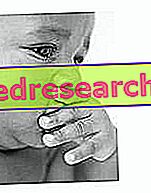What is apraxia?
In the absence of elementary neurological lesions of motor or sensory nature, we speak of apraxia when the subject shows an evident difficulty or inability to perform voluntary movements.

Most patients suffering from apraxia are not aware of their own ailment: we speak of anosognosia, the patient's inability to recognize his own neuropsychological deficit.
Meaning of apraxia
The term apraxia derives from the Greek a-praxia : the prefix a- indicates a negation, while the suffix –praxìa means to do (literally non-doing, impossibility to do). At the beginning of the 1870s, the doctor Steinthal coined the term first, but inserted it in a wrong context, correlated above all to the aphasic syndrome. A century later, another scientist correctly reassessed the term, which took on its current meaning: inability to perform and / or control a voluntary movement .
Causes
Apraxia results from secondary cerebral pathologies and is never due to dystonia, dyskinesia or ataxia. The most common etiological factor responsible for the disease is certainly attributable to a cerebrovascular lesion: in fact, the most frequent apraxias are mainly due to thrombotic or embolic infarcts, long-term hemodialysis, stroke and brain tumors. A close correlation has been observed between Alzheimer's disease and other neurodegenerative diseases in general, and apraxia. In some cases, apraxia can worsen following concomitant psychological illnesses (eg psychogenic motor dysfunction associated with organic pathologies).
The apraxia can be generated by lesions - often partial - against the corpus callosum; in general, these injuries cause damage to the left half of the body. Only when the dominant cerebral hemisphere (left, responsible for motor coordination) is affected, does the patient run the risk of apraxia; brain damage to the non-dominant (right) hemisphere does not cause apraxia.
The apraxia of the corpus callosum involves only the limbs, leaving the facial ones unharmed. [taken from Neurophysiology of movement: anatomy, biomechanics, clinical kinesiology, by M. Marchetti, P. Pilastrini]
Symptoms
The range of motor disorders that can be summarized in apraxia usually affects the arm muscles, while those of the legs and face are only rarely affected; the apraxia of the trunk is debatable.
The disorders that complete the symptomatological picture of apraxic disorder can be summarized in some main points, shown below in the table:
Clinical aspect of apraxia (design errors)
- Introduction of innovative elements during a gesture
- Lack of some indispensable elements for the completion of a movement
- Replacement of a movement with another incomprehensible
- Bizarre realization of the gesture
- Preservation of the movement: the patient continues to repeat that given gesture
- Temporal coordination: the subject apraxis does not remember the correct sequence of movements aimed at achieving a complete meaningful gesture
- The subject suffering from apraxia uses the hand or fingers as if they were the object (object = hand)



